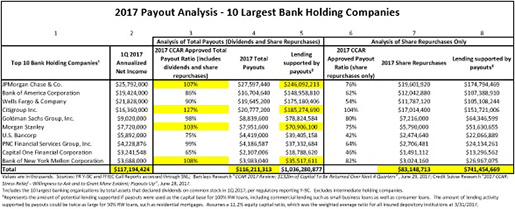Federal Bank Regulator Drops a Bombshell as Corporate Media Snoozes

Last Monday, Thomas Hoenig, the Vice Chairman of the Federal Deposit Insurance Corporation (FDIC), sent a stunning letter to the Chair and Ranking Member of the U.S. Senate Banking Committee. The letter contained information that should have become front page news at every business wire service and the leading business newspapers. But with the exception of Reuters, major corporate media like the Wall Street Journal, Bloomberg News, the Business section of the New York Times and Washington Post ignored the bombshell story, according to our search at Google News.
What the fearless Hoenig told the Senate Banking Committee was effectively this: the biggest Wall Street banks have been lying to the American people that overly stringent capital rules by their regulators are constraining their ability to lend to consumers and businesses. What’s really behind their inability to make more loans is the documented fact that the 10 largest banks in the country “will distribute, in aggregate, 99 percent of their net income on an annualized basis,” by paying out dividends to shareholders and buying back excessive amounts of their own stock....MORE
Hoenig writes that the banks are starving the U.S. economy through these practices and if “the 10 largest U.S. Bank Holding Companies were to retain a greater share of their earnings earmarked for dividends and share buybacks in 2017 they would be able to increase loans by more than $1 trillion, which is greater than 5 percent of annual U.S. GDP.”
Backing up his assertions, Hoenig provided a chart showing payouts on a bank-by-bank basis. Highlighted in yellow on Hoenig’s chart is the fact that four of the big Wall Street banks are set to pay out more than 100 percent of earnings: Citigroup 127 percent; Bank of New York Mellon 108 percent; JPMorgan Chase 107 percent and Morgan Stanley 103 percent.
What’s motivating this payout binge at the banks? Hoenig doesn’t offer an opinion in his letter but he does state that share buybacks represent 72 percent of the total payouts for the 10 largest bank holding companies. What share buybacks do for top management at these banks is to make the share price of their bank’s stock look far better than it otherwise would while making themselves rich on their stock options. If just the share buybacks (forgetting about the dividend payouts) were retained by the banks instead of being paid out, the banks could “increase small business loans by three quarters of a trillion dollars or mortgage loans by almost one and a half trillion dollars.”...
HT: Mike Norman Economics, August 9 where the first comment is basically "Cool, if they want to play that game here are the new rules:
Ralph Musgrave said...Do read Vice-chair Hoenig's letter, it's only three pages, including a readable version of the table at the top of this post:
Martin Wolf (chief economics commentator at the Financial Times) and Anat Admati (economics prof at Stanford) have called for bank capital ratios to be about 25%, i.e. about ten times higher than they currently are. But even better would be a 100% ratio, as advocated by Milton Friedman and others.
Reason is that it is precisely the fact of funding bank loans via deposits that enables private banks to create or “print” money. In contrast, under a 100% capital ratio they can’t. And money printing amounts to robbing the community at large.
Everyone has heard of the TBTF subsidy. Unfortunately very few people have got to grips with the “money printing” bank subsidy.
https://www.fdic.gov/about/learn/board/hoenig/hoenigletter07-31-2017.pdf